Atapuerca
Yacimiento Arqueológico de Atapuerca
Useful Information
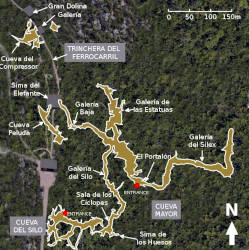
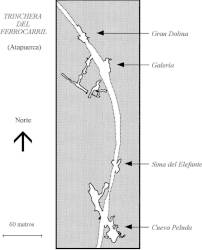
| Location: |
Cam. del Pajarillo, 09198 Ibeas de Juarros, Burgos.
20 km east of Burgos. N-120 Logroño-Vigo, at km 93,5 turn offf to Santovenio de Oca and San Juan, after 500 m turn off to Atapuerca. (42.3487609, -3.5194599) |
| Open: |
Museo Evolución Humana:
All year Tue-Fri 10-14:30, 16:30-20, Sat, Sun, Hol 10-20. Sites: APR to OCT Tue-Fri 11, 15, Sat 10-13, 16, 17, Sun 10-13. Reservation mandatory. Experimental Archaeology Centre (CAREX): All year Tue-Sat 9:30-17:30, Sun, Hol 9:30-15. [2024] |
| Fee: |
Museo Evolución Humana:
Adults EUR 6, Children (8-18) EUR 4, Children (0-7) free, Students EUR 4, Seniors (65+) free, Unemployed free, Disabled free. Sites: Adults EUR 6, Children (8-18) EUR 5, Children (0-7) free, Students EUR 5, Seniors (65+) free, Unemployed free, Disabled free. Experimental Archaeology Centre (CAREX): Adults EUR 5, Children (8-18) EUR 4, Children (0-7) free, Students EUR 4, Seniors (65+) free, Unemployed EUR 4, Disabled free. [2024] |
| Classification: |
 Karst Cave Karst Cave
|
| Light: |
 Incandescent Incandescent
|
| Dimension: | |
| Guided tours: | D=3 h. |
| Photography: | allowed |
| Accessibility: | no |
| Bibliography: | |
| Address: |
Los Yacimientos de la Sierra de Atapuerca, Cam. del Pajarillo, 09198 Ibeas de Juarros, Burgos, Tel: +34-947-42-10-00.
Fundación Atapuerca, Carretera de Logroño, 44 - 09198 Ibeas de Juarros (Burgos, Spain), Tel: +34-947-257-067. E-mail: Reservation: Tel: +34-947-421-000. E-mail: |
| As far as we know this information was accurate when it was published (see years in brackets), but may have changed since then. Please check rates and details directly with the companies in question if you need more recent info. |
|
History
| 189? | Trinchera de Ferrocaril built. |
| 192? | railroad closed. |
| 194? | quarrying in the Trinchera. |
| 1960-1980 | excavations by different people. |
| 197? | quarrying stopped. |
| 1978 | first excavations by Prof. Emiliano Aguirre. |
| 1992 | ancient fossils unearthed in Sima de los Huesos. |
| 1994 | discovery of 900,000-year-old human remains which define a new species, Homo antecessor. |
| 26-JUL-1999 | Atapuerca Foundation constituted by the three co-directors Juan Luis Arsuaga José María Bermúdez de Castro and Eudald Carbonell. |
| 2000 | inscribed on the UNESCO World Heritage List. |
Description


Atapuerca is the name of a sierra, a mountain ridge, and also of the village in the southern foothills. This sierra is an extraordinary place, even for Spain. Los Yacimientos de la Sierra de Atapuerca (The Sites of the Sierra de Atapuerca) is the name of the numerous caves, archaeological excavations, and the museum. We have listed this primarily archaeological site, because there are several karst-related sites, but the caves are small and there is actually no underground tour. Most sites are open air, in dolines, overhanging cliffs and small caves which have collapsed. Nevertheless, without the karst there would be much less archaeological remains.
The Yacimiento Arqueológico de Atapuerca (Archaeological Site of Atapuerca) is located 15 km east of Burgos at the foot of the San Vincent hill (1085 m asl). About a dozen sites bore the remains of humans and animals from more than 1 Million years ago to the present. Fossil remains of five different hominid species along with evidence of their presence have been found at the Sierra de Atapuerca sites. Homo sp. (yet to be defined, 1,300,000 years), Homo antecessor (850,000 years), Homo preneanderthalensis (500,000 years), Homo neanderthalensis (50,000 years) and Homo sapiens. Most of the sites are caves, several of them were discovered as a result of the construction of a railway line. For this purpose a trench was cut into the foot of the hill and sediment filled caves discovered.
The whole site was discovered at the end of the 19th century. English engineers built a railroad through the Sierra de Atapuerca, to transport iron ore and coal from the Sierra de la Demanda to Burgos. To cross the Sierra de Atapuerca, they made a trench, which was called la Trinchera de Ferrocaril (railroad trench). Doing this, they cut through many caves and made them accessible. Later, quarrying opened even more caves with 18 to 20 m thick layers full of important findings. Finally, their importance was recognized and the quarrying stopped.
There are numerous sites in the area, which were excavated in the following chronological order. The Yacimiento Gran Dolina (Gran Dolina Site), the Complejo Tres Sima (Three Pits Complex), and the Yacimiento del Elephante (Elephant Site). A man-made trench opened two caves, the Complejo Cueva Major (Cueva Major Complex) and the Cueva del Silo, also called Cueva Peluda. The visit shows various sites along the Trinchera de Ferrocaril. Several other sites are not open to the public.
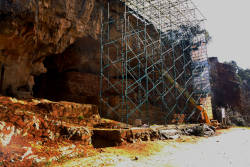
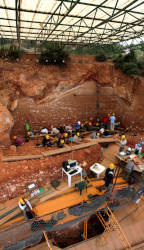
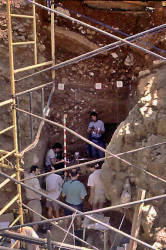
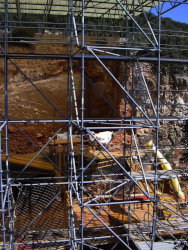
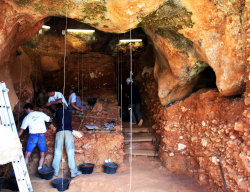
 Subterranean World Heritage List
Subterranean World Heritage List Search DuckDuckGo for "Los Yacimientos de la Sierra de Atapuerca"
Search DuckDuckGo for "Los Yacimientos de la Sierra de Atapuerca" Google Earth Placemark
Google Earth Placemark OpenStreetMap
OpenStreetMap Sierra de Atapuerca sites (visited: 22-FEB-2024)
Sierra de Atapuerca sites (visited: 22-FEB-2024) Index
Index Topics
Topics Hierarchical
Hierarchical Countries
Countries Maps
Maps